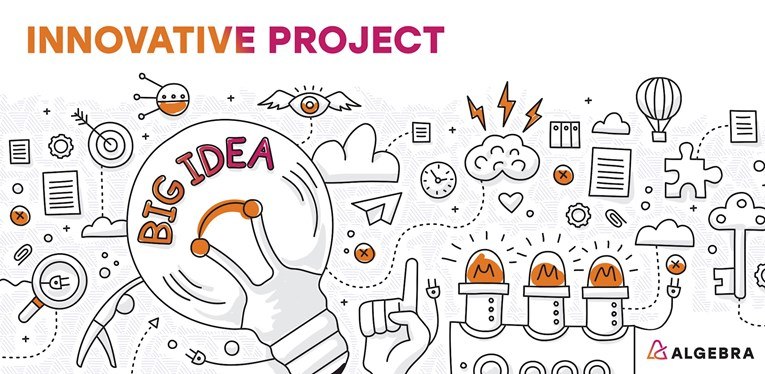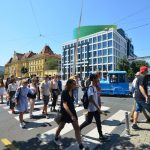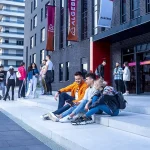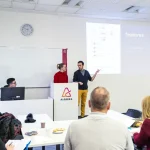We present you the fifteen Algebra students, who decided to change their surroundings for the better with the help of advanced technology while working on their degrees. These are the future Algebra graduates who, as part of the Innovative Project course, come up with ideas and products that aim to change the world today and tomorrow!
One of the teams we present to you today considered how to make it easier and simpler for all wine lovers to find wines and wineries in Croatia. They came up with a digital wine atlas called Wineata, which makes it easier for wine lovers to access information about quality wines, wineries and wine tours available throughout Croatia. The project is closely monitored by mentors – Stella Antolović and Silvio Papić, and the team is formed by nine students from different areas of Algebra graduate studies – Karlo Jakobović, Marko Sabolić, Jurica Slovinac, Luka Žgrablić, Suraj C. R. C. Reddy, Elma Melkić, Jigisha H. Shah, Yacine Akki and Celina Wedershoven.
1. You came up with an application that is a wine atlas of sorts – where did you get the idea?
At the beginning of this story, we talked a lot about possible ideas and projects that could be realized, but together we agreed on the fact that wine lovers on the market cannot find interesting wineries or information about different varieties of wine so easily. At the introductory lectures of the Innovative project course, we had the opportunity to further develop our idea – where we agreed together that this is the right project for us and what the market and consumers need.
2. What challenges did you face during the development of Wineata?
It is challenging to predict what will happen in the market after the COVID-19 pandemic. We are aware that the research of the wine world depends significantly on the situation in the market, therefore the biggest challenge we have faced is the collection of all relevant data on time. However, when the team is committed and passionate, things work. Another challenge was the cooperation of different team members from different fields. Teamwork is our biggest advantage, once we managed to get along, understand and accept the common direction in which the project was to develop, we quickly came up with interesting solutions.
3. You conducted a survey that served as a starting point for creating the application – what did the results show? Does Croatia need an application that will make it easier to find quality wine destinations?
The survey results are very interesting. We created one survey for the Croatian market and one customized survey for tourists. Of the total number of respondents, 7.6% drink wine every day, 9.7% drink wine three times a week, and 22.4% drink wine once a week. We can conclude that almost half of the respondents, more precisely 39.7% of them, drink wine at least once a week. When asked where they most often buy wine, 52.7% answered that they buy in large stores (supermarkets), 15.6% answered in wineries, and 11.4% in wine shops. This is good news for our application. This means that respondents visit wineries and wine shops, and we can provide them with a better experience of visiting these places. The aim of this research is to understand their habits and how we can improve their wine experiences through our application. Of the total number of respondents, 69.2% said they would like to visit wineries in Croatia, and 21.1% of respondents were not sure. Of the total number of respondents, 17.3% would use an application that would help them find wineries and their offers in Croatia, 35.4% agree, and 22.8% are unsure. From this question, we can recognize that there is potential for our application and that users are willing to use this type of application.
4. Wineata was designed by an interdisciplinary Algebra team – how did this collaboration work?
We believe that no business works as well as it could with just one specialized function or with the same way of thinking. This was a unique opportunity to experience in practice what it’s like to work in an interdisciplinary team because we are sure that in the future such an opportunity will be presented to us in the business world, and this interesting project prepared us for that situation.
5. Do you think the market will recognize the value of Wineata and how do you plan to approach your target audience?
We believe that the market will recognize the benefits offered by Wineata, mostly because it will be created with the purpose of helping consumers navigate the world of wine. Wineata will combine offline and online experiences and provide relevant and up-to-date information to consumers. It will combine different moments of consumption, such as daytime or evening gatherings with wine or a combination of food and wine. Wineata is there for the consumer, ready to provide them with personalized advice.
6. Do you have plans for an expansion beyond the borders of Croatia?
Of course, we plan to expand beyond the borders of Croatia in the future. We believe that this project has great potential for acceptance in other markets as well. According to Statista, the consumption of wine in the world in 2021 is estimated at 236 million hectoliters, which is a decrease compared to 241 million hectoliters in 2019. We believe that the market will recover during 2023 and that we will attract the attention of consumers on the global market with our interactive wine list of the world. Consumers will be able to explore interesting locations and events near them, read reviews and learn about wines. Our platform will be completely personalized for the user who uses it, which we believe consumers will recognize as a benefit and use it every day.
The second team of the Algebra graduates that we are introducing is the interdisciplinary team of Krivovizija (crooked vision), which works on an artistic platform and functions on the basis of blockchain technology. If you are wondering what blockchain is and how it can be used to develop art – read on! These ingenious young people have made it possible for artists to upload their artwork and create their digital portfolios on their platform. However, the platform is not intended only for artists, but also for buyers of art and the interested public. The team consists of six Algebra students: Tomislav Čavala, Fran Bartolić, Ena Saško, Ivan Popović, Karlo Bertina and Maxime Coutin, backed by mentors Karlo Josić and Halida Sarajlić. Ivan Popović answered on behalf of the team, who explained to us what blockchain is and how they connected blockchain and art.
1. Can you briefly explain to us how Krivovizija was created and what it brings to its potential users?
The project actually had a development path which was quite different at the beginning from the current version, i.e. the first variants of the idea were much more focused on blockchain technology, motivated by the fact that the term “NFT” has exploded in popularity in the last few years. However, as we were developing the idea, we ran into several obstacles and we came to the realization that ultimately we want to create something that will have integrated modern digital technology, but above all something that will create long-term value for users. What our idea brings to its users is simply the possibility of learning, creating “digital works”, presenting them on the global market, and freely interacting with other users who share interests in the same things. In this specific case, it refers to digital arts such as pictures, photographs, comics, etc…
2. What did team collaboration look like during the creation of Krivovizija? Who came up with the name?
Like any project, we believe that there are countless good ideas, but no matter how good an idea is, in the end, everything will depend on some kind of compatibility and interaction of the team members who bring it to life. We were lucky that a group of people who have adequate knowledge and motivation to build something of this magnitude got together. As for the name, Krivovizija is primarily our team’s “code” name, and the source of the name is not overly praiseworthy if we are honest. If we had known that someone would ask us this, we probably would have chosen something else. Basically, one of the team members came up with the information that there is a website that randomly generates words that are somehow inspired by terms that were used in the former Yugoslavia. There were quite a few options, but we agreed that Krivovizija was the best choice.
3. Krivovizija is built on blockchain technology. Explain to us laypeople what exactly blockchain technology is.
Here we will mention blockchain in two contexts. In its basic form, it is a technology that refers to the decentralized storage of information that is impossible to change or copy. Since that may sound a bit abstract, we will mention another context related to our project. So, simply put, we use blockchain technology primarily to protect the ownership of our users’ digital assets. If, for example, someone buys a digital photo, we will ensure that the owner is the sole owner and that someone cannot show up somewhere with a copy and claim to own the original.
4. How did you decide to develop a platform that is intended specifically for artists and art lovers?
The popularity of digital art has grown exponentially over the past few years, technology has become more accessible, there are more and more talented people, and the global COVID situation has significantly accelerated the transition of a large number of our activities to digital spheres. In addition, studying the current state of the market, we realized that there is a great opportunity to build a platform of this type, and we believe that now is the ideal time for such an undertaking.
5. Where do you see your advantage over your competitors? How will you stand out in the market?
Currently, there are several somewhat similar platforms, but all of them are related to a specific domain, so none of them is adequate to be used by a wider group of users possessing different talents. Some of the platforms are focused exclusively on photography, some only on 3D animation, etc. But the most important thing to mention is that the social aspect is not in focus in any of them or it is extremely limited, and we consider that our biggest advantage. So, in addition to the aforementioned blockchain technology that we use in terms of protection, we want our users to use the platform as a social network where they can learn about the tools they are interested in, present their talents globally, communicate openly and create interest groups, and ultimately make a living from their work.











